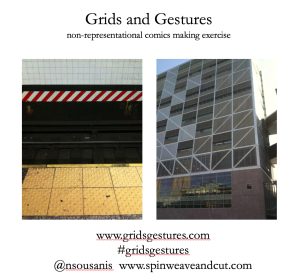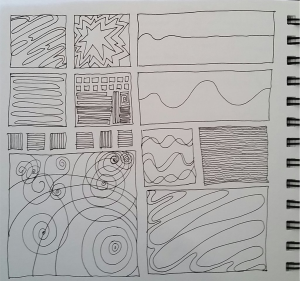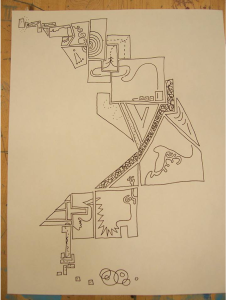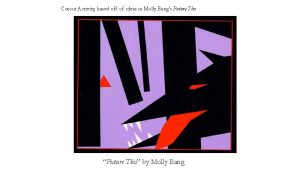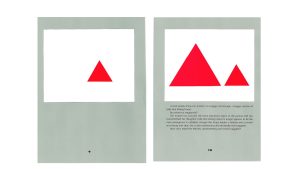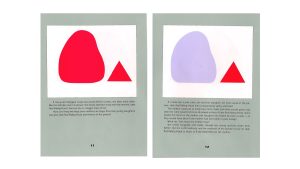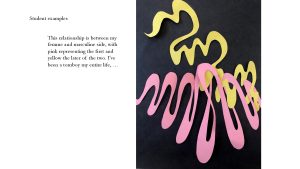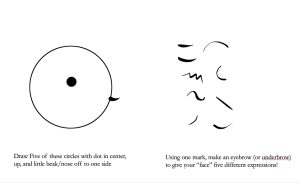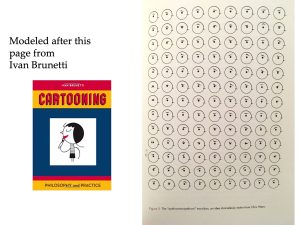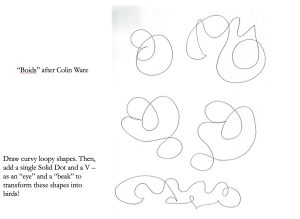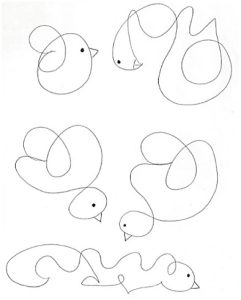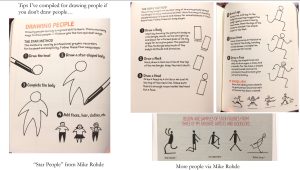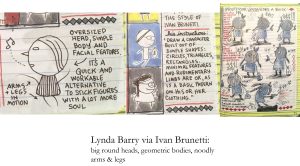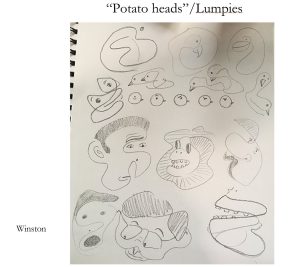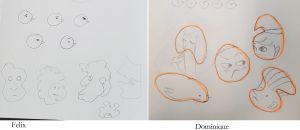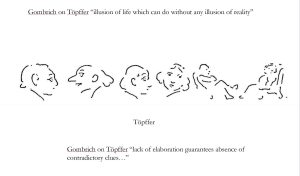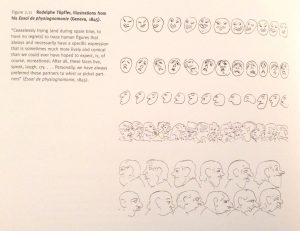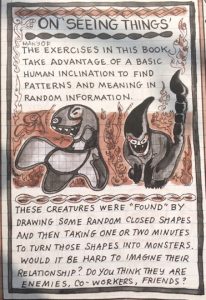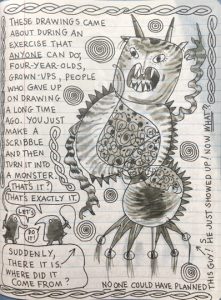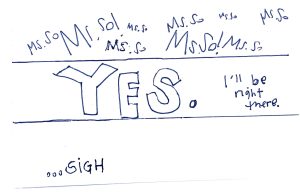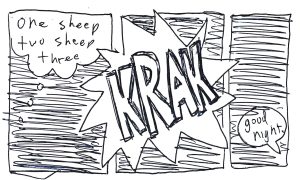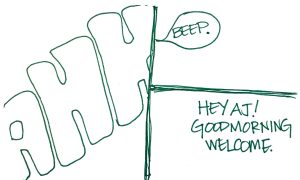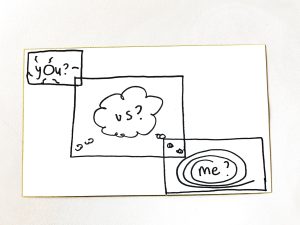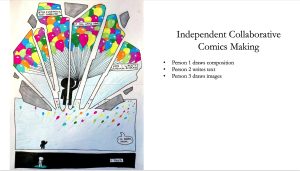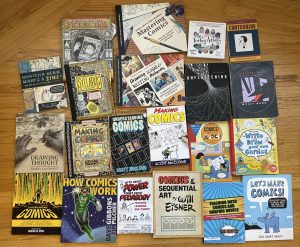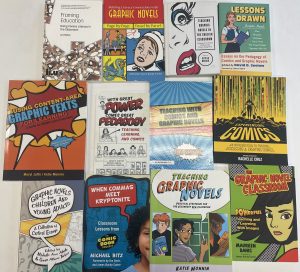I made this to go with a workshop I gave for SFUSD teachers February 15, 2023.
Materials: Paper, index cards, pens, pencils, & scissors!
I’ve got two chapters on my teaching in the book With Great Power Comes Great Pedagogy – the overview of all I do in classes is available on their free excerpt here. It mostly draws on stuff posted on the main education part of my site, but in a more narrative and easily accessible form. I also made a page here on teaching your own comics-making class.
- Workshop sequence:
- Overview of SFSU Comics Studies Program/Classes and some things we do including sketchnotes, visual analysis, and examples of student work.
- ACTIVITY: Grids & Gestures – My non-representational comics-making exercise that I kick off all courses & talks with. Gets you thinking about how comics work and how much you likely already know about drawing. See it fully described with examples, video explainer, and an academic article version all here.
- Reflection on G&G, additional activity touched on – find a neat example of real architecture and use it as the basis for the composition of a comics page.
-
- ACTIVITY: Quick emotional lines – in about seven seconds, people draw a line that is happy, angry, sad, strong, … Detailed instructions in PDF here.
- Additionally, you might try the Storyline Activity detailed here
- I then shared Jarod Roselló‘s comic on not being able to sit still in class – and needing to draw https://pankmagazine.com/2014/05/29/gutter/
- ACTIVITY: Quick emotional lines – in about seven seconds, people draw a line that is happy, angry, sad, strong, … Detailed instructions in PDF here.
-
-
- Reflection – what you can do with cutouts, Molly Bang’s Picture This. I do activities with cutouts – having students depict some sort of relationship using cutouts only focusing on color, shape, and spatial arrangement, based on how Molly Bang talks about depicting Little Red Riding Hood as a red triangle and trying to figure out what color and shape to best make LRRH’s mother. I made a PDF explaining it here.
-
-
-
- ACTIVITY: eyebrows (connect to emotional lines). Detailed slides on it in PDF Here.
-
-
-
- ACTIVITY: Boids – draw some loopy, curvy shapes – add a dot and a V – to create birds! PDF here.
-
-
-
- ACTIVITY: Simple People examples from Mike Rohde, Lynda Barry. Copy their examples – handy to have these ways of drawing, particularly for those who don’t have much experience drawing. See PDF here for examples.
-
-
-
- BONUS Activity (didn’t have time in workshop): Lumpies! Pretty simple, draw some closed in, lumpy (like a bumpy potato) amorphous shapes. Then, turn them into faces. This is inspired by Töpffer’s observations on cartooning! Pretty quick, always generates good drawings and dovetails nicely with the Lynda Barry “monster” activity following…
-
-
-
- ACTIVITY: Lynda Barry Monsters: This is all Lynda Barry’s activity – but always a blast. Essentially, have people draw squiggly shapes and see who shows up!
- Index card reflection – this is on how Frederik Køhlert and I used Index Cards as way of getting students in a large class to still do drawing in each class and learn comics making. Fast five minute activities, single notecard.
-
-
- ACTIVITY: Mini-pictureless comics activity – do on index cards! Examples above came from teachers in the workshop – done in maybe three minutes.
- Instructions: make a quick, 3-panel comic with NO pictures – only words, sound effects, word balloons, thought bubbles, captions, those sorts of things…
- ACTIVITY: Mini-pictureless comics activity – do on index cards! Examples above came from teachers in the workshop – done in maybe three minutes.
- My favorite 3-person collaborative comic – made in a class back in 2015…
-
- ACTIVITY: 3-person Collaborative
- Independent Collaborative Comics Making: Person 1 draws composition; Person 2 writes text; Person 3 draws images. Always a blast!
- ACTIVITY: 3-person Collaborative
-
- ACTIVITY: Minicomics construction. You can see my mini-comic on safe streets in SF and a video of me explaining it here!
- With enough time, I would’ve done this improv mini-comic with the following set of rules:
- Do the Cover Last! – we’ll come back to that at the end…
- Each page can act as a single panel – or – you can divide pages into multiple panels if you choose.
- Here are some prompts to include across the pages of your mini-comic.
- [Stuck on any step – close eyes, make random squiggly mark on page – use it as part of your composition… *Consider doing the prompts for different pages out of order]
- With enough time, I would’ve done this improv mini-comic with the following set of rules:
- ACTIVITY: Minicomics construction. You can see my mini-comic on safe streets in SF and a video of me explaining it here!
-
-
-
-
- Set the scene
- Introduce your character. Give them an expression, exclamation, introducing the character and setting the mood.
- And 4 together, if you want as a two-page spread. Think of a song, movie reference, or a recent text/message on your phone – incorporate it into the narrative. The text can be a line of dialogue, thought, narrative caption, sound effects, background noise, on a billboard, book jacket… . This sets up action or conflict in motion
- Again, can do 3 and 4 together or as separate pages.
- Immediate response.
- Resolution – or view from the future. Finish however you want.
- Back page – your avatar, promo, website, those things. And if you want, a little coda/postscript for your story.
- Do the Cover – Add a TITLE and relevant imagery to capture essence of your tale. Don’t forget to add byline!
-
-
-
-
-
-
- BONUS: A page or panel with no words or images, just marks or textures—create a mood OR Try a panel or page with only words or sound effects, no pictures
- Reflection: some tools on asking your own questions to create narratives (Thi Bui family history example, graphic medicine)
-
- BONUS – thumbnail explanation/activity
- Whew!
-
- Covers of books I use to think about teaching making comics, missing most notably Matt Madden’s 99 Ways to Tell a Story
Some readings I drew on to put this together, pictured above and written below:
- Lynda Barry Syllabus, Picture This, and Making Comics
- Molly Bang Picture This
- Rudolph Arnheim Visual Thinking and Art and Visual Perception
- Andrea Kantrowitz Drawing Thought
- Mike Rohde Sketchnote Handbook
- Works of Bruno Munari
- Lakoff & Johnson Metaphors We Live By and Philosophy in the Flesh
- Matt Madden 99 Ways to Tell a Story
- Matt Madden & Jessica Abel Drawing Words & Writing Pictures
- Scott McCloud Understanding Comics, Making Comics


